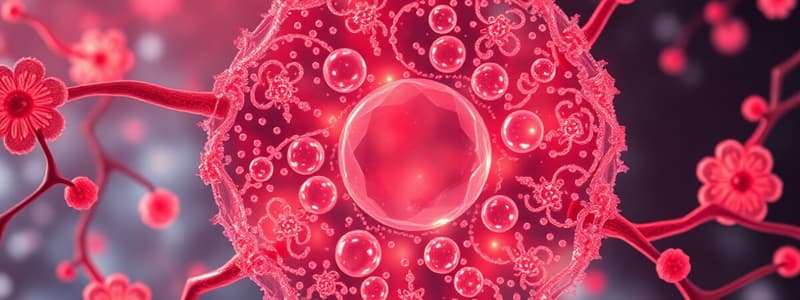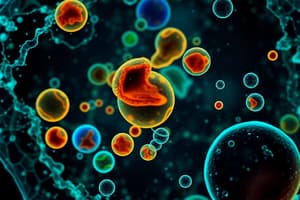Podcast
Questions and Answers
Which of the following best describes the cytoplasm of a cell?
Which of the following best describes the cytoplasm of a cell?
- The site of energy conversion within the cell (mitochondria).
- All cellular contents excluding the nucleus. (correct)
- The genetic material (DNA and RNA) within the nucleus.
- The fluid that fills the cell and suspends organelles.
What is the primary function of the Golgi body (Golgi apparatus)?
What is the primary function of the Golgi body (Golgi apparatus)?
- Breaking down old cell structures and endocytosed material.
- Synthesizing proteins from RNA templates.
- Generating energy for the cell through cellular respiration.
- Processing, packaging, and distributing macromolecules. (correct)
Which cellular structure is responsible for the process of translation?
Which cellular structure is responsible for the process of translation?
- Lysosomes
- Vesicles
- Peroxisomes
- Ribosomes (correct)
What role does the cytoskeleton play in a cell?
What role does the cytoskeleton play in a cell?
Which organelles are primarily involved in the breakdown and recycling of cellular materials?
Which organelles are primarily involved in the breakdown and recycling of cellular materials?
What components, besides the nucleus, are contained within the cell membrane and constitute the cytoplasm?
What components, besides the nucleus, are contained within the cell membrane and constitute the cytoplasm?
Who is credited with the discovery of the cytoplasm, and in what year did this discovery take place?
Who is credited with the discovery of the cytoplasm, and in what year did this discovery take place?
What primary roles does the cytoplasm play in cell function?
What primary roles does the cytoplasm play in cell function?
How does the cytoplasm's gel-like nature contribute to cell function?
How does the cytoplasm's gel-like nature contribute to cell function?
What role do vesicles and the cytoskeleton play in cytoplasmic transport?
What role do vesicles and the cytoskeleton play in cytoplasmic transport?
Flashcards
Cytoplasm
Cytoplasm
The material within a cell, excluding the nucleus.
Organelles
Organelles
Specialized structures within a cell performing various functions.
Rough Endoplasmic Reticulum (RER)
Rough Endoplasmic Reticulum (RER)
Part of the ER with ribosomes, site of protein synthesis.
Golgi Body
Golgi Body
Signup and view all the flashcards
Mitochondria
Mitochondria
Signup and view all the flashcards
Cytosol
Cytosol
Signup and view all the flashcards
Cytoskeleton
Cytoskeleton
Signup and view all the flashcards
Cytoplasmic Inclusions
Cytoplasmic Inclusions
Signup and view all the flashcards
Functions of Cytoplasm
Functions of Cytoplasm
Signup and view all the flashcards
Study Notes
Cytoplasm: The Cell's Interior
- Definition: Cytoplasm is everything inside a cell membrane, excluding the nucleus.
- Etymology: Derived from "cyto" (cell) and "plasm" (molded/formed).
- Discovery: First used by Rudolph von Kolliker (1863); discovered in its entirety by George E Palade, Albert Claude, and Christian de Duve (1835).
- Structure: Consists of cytosol, organelles (excluding the nucleus), cytoskeleton, and cytoplasmic inclusions.
- Cytosol: The fluid portion, mainly water, containing dissolved ions and the site of metabolic reactions.
- Organelles: Structures specialized for specific tasks within the cell (e.g., nucleus, endoplasmic reticulum, Golgi body, mitochondria, lysosomes, peroxisomes).
- Cytoskeleton: Fiber-like framework maintaining cell shape, providing support, and enabling intracellular transport.
- Cytoplasmic Inclusions: Vesicles, vacuoles, or other molecules/materials stored within the cytoplasm.
Cytoplasm Functions
- Transport: Vesicles and cytoskeleton facilitate movement of molecules throughout the cell.
- Shape and Structure Maintenance: Cytosol and cytoskeleton maintain cellular volume and shape.
- Protection: The gel-like nature of the cytoplasm protects organelles from damage.
- Storage: Stores water, macromolecules, and ions.
- Metabolism: Site of diverse metabolic reactions including glycolysis—a vital component of cellular respiration.
Studying That Suits You
Use AI to generate personalized quizzes and flashcards to suit your learning preferences.





